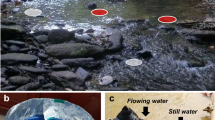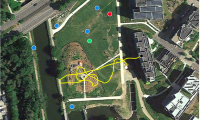Abstract
Camponotus schmitzi ants live in symbiosis with the Bornean pitcher plant Nepenthes bicalcarata. Unique among ants, the workers regularly dive and swim in the pitcher’s digestive fluid to forage for food. High-speed motion analysis revealed that C. schmitzi ants swim at the surface with all legs submerged, with an alternating tripod pattern. Compared to running, swimming involves lower stepping frequencies and larger phase delays within the legs of each tripod. Swimming ants move front and middle legs faster and keep them more extended during the power stroke than during the return stroke. Thrust estimates calculated from three-dimensional leg kinematics using a blade-element approach confirmed that forward propulsion is mainly achieved by the front and middle legs. The hind legs move much less, suggesting that they mainly serve for steering. Experiments with tethered C. schmitzi ants showed that characteristic swimming movements can be triggered by submersion in water. This reaction was absent in another Camponotus species investigated. Our study demonstrates how insects can use the same locomotory system and similar gait patterns for moving on land and in water. We discuss insect adaptations for aquatic/amphibious lifestyles and the special adaptations of C. schmitzi to living on an insect-trapping pitcher plant.








Similar content being viewed by others
References
Abdel-Aziz YI, Karara HM (1971) Direct linear transformation from comparator coordinates into object space coordinates in close-range photogrammetry. In: Proceedings of the Symposium on Close-Range Photogrammetry, American Society of Photogrammetry, Falls Church, VA, pp 1–18
Adam JH (1997) Prey spectra of Bornean Nepenthes species (Nepenthaceae) in relation to their habitat. Pertanika J Trop Agric Sci 20:121–134
Alexander RM (1982) Locomotion of animals. Blackie, Glasgow
Attenborough D (2005) Life in the undergrowth. In: Bassett P, Salisbury M, Appleby B, Dunleavy S (eds) Life. BBC
Barnes WJP, Barth FG (1991) Sensory control of locomotor mode in semi-aquatic spiders. In: Armstrong DM, Bush BMH (eds) Locomotor neural mechanisms in arthropods and vertebrates. Manchester Univ Press, Manchester, pp 105–116
Bässler U, Büschges A (1998) Pattern generation for stick insect walking movements—multisensory control of a locomotor program. Brain Res Rev 27:65–88
Bohn HF, Federle W (2004) Insect aquaplaning: Nepenthes pitcher plants capture prey with the peristome, a fully wettable water-lubricated anisotropic surface. Proc Natl Acad Sci USA 101:14138–14143
Bowdan E (1978) Walking and rowing in the water strider, Gerris remigis. I. A cinematographic analysis of walking. J Comp Physiol A 123:43–49
Brady SG, Gadau J, Ward PS (2000) Systematics of the ant genus Camponotus (Hymenoptera: Formicidae) a preliminary analysis using data from the mitochondrial gene cytochrome oxidase I. In: Austin AD, Dowton M (eds) Hymenoptera. Evolution, biodiversity and biological control. CSIRO Publishing, Collingwood, pp 131–139
Burbidge FW (1880) Nepenthes bicalcarata. Gard Chron New Ser 13:264–265
Clarke CM, Kitching RL (1995) Swimming ants and pitcher plants: a unique ant-plant interaction from Borneo. J Trop Ecol 11:589–602
Cruse H, Dürr V, Schilling M, Schmitz J (2009) Principles of insect locomotion. In: Arena P, Patanè L (eds) Spatial temporal patterns for action-oriented perception in roving robots, vol 1. Springer, Berlin, pp 43–96
Daniel TL (1984) Unsteady aspects of aquatic locomotion. Am Zool 24:121–134
DuBois MB, Jander R (1985) Leg coordination and swimming in an ant, Camponotus americanus. Physiol Entomol 10:267–270
Ellington CP (1991) Aerodynamics and the origin of insect flight. Adv Insect Physiol 23:171–210
Full RJ, Tu MS (1990) Mechanics of six-legged runners. J Exp Biol 148:129–146
Graham D (1985) Pattern and control of walking in insects. Adv Insect Physiol 18:31–140
Hughes GM (1952) The co-ordination of insect movements I. The walking movement of insects. J Exp Biol 29:267–284
Hughes GM (1958) The co-ordination of insect movements: III. Swimming in Dytiscus, Hydrophilus and a dragonfly nymph. J Exp Biol 35:567–583
Merbach MA, Zizka G, Fiala B, Merbach D, Maschwitz U (1999) Giant nectaries in the peristome thorns of the pitcher plant Nepenthes bicalcarata Hooker f. (Nepenthaceae): anatomy and functional aspects. Ecotrop 5:45–50
Nielsen MG (1997) Nesting biology of the mangrove mud-nesting ant Polyrhachis sokolova Forel (Hymenoptera, Formicidae) in northern Australia. Insectes Soc 44:15–21
Pflüger H-J, Burrows M (1978) Locusts use the same basic motor pattern in swimming as in jumping and kicking. J Exp Biol 75:81–93
Schuitemaker JP, Staercke A (1933) Contributions à l’étude de la faune Nepenthicole. Art. III. Un noveau Camponotus de Borneo, habitant les tiges creuses de Nepenthes. Natuurhistorisch Maandblad 22:29–31
Shumakova I, Fursov V, Gladun D, Frantsevich L (2003) Swimming in the diving wasp Prestwichia aquatica (Hymenoptera: Trichogrammatidae). Entomol Gen 26:225–234
Ting LH, Blickhan R, Full RJ (1994) Dynamic and static stability in hexapedal runners. J Exp Biol 197:251–269
Vogel S (1981) Life in moving fluids. Princeton University Press, Princeton
Wendler G, Teuber H, Jander JP (1985) Walking, swimming and intermediate locomotion in Nepa rubra. In: Gewecke M, Wendler G (eds) Insect locomotion. Paul Parey, Berlin, pp 103–110
Zollikofer CP (1994) Stepping patterns in ants I. Influence of speed and curvature. J Exp Biol 192:95–106
Acknowledgments
We thank the Leverhulme Trust (F/09 364/G) and the German Research Foundation (Emmy-Noether Programme FE 547/1) for financial support of this study. We thank Charlie Ellington for giving us useful information for the thrust analysis, Karin Moll for advice on statistics, and Uri Grodzinski for his help with the behavioral analysis. Components of the KineMat MATLAB Toolbox by Christoph Reinschmidt and Ton van den Bogert were used for the three-dimensional kinematic analysis.
Author information
Authors and Affiliations
Corresponding authors
Electronic supplementary material
Below is the link to the electronic supplementary material.
Video 1: Natural swimming and foraging behavior of two C. schmitzi ants inside a pitcher of Nepenthes bicalcarata recorded in the field in Brunei. The ants can be seen going underwater along the pitcher wall, searching the remnants of captured prey at the bottom of the pitcher, re-surfacing by their buoyancy and swimming along the surface with open mandibles. Both ants are in the middle of a “swimming bout” consisting of cycles of swimming, diving and re-surfacing. Supplementary material 1 (MPG 8019 kb)
Videos 2 and 3: C. schmitzi worker swimming at the water surface, recorded at 100 Hz in an observation tank. Video 2: Side view; Video 3: Top view. Supplementary material 2 (AVI 934 kb)
Supplementary material 3 (AVI 888 kb)
Appendix: Blade element calculation of drag and thrust
Appendix: Blade element calculation of drag and thrust
As only the coxae and foot tips were digitised in the 3D recordings of swimming C. schmitzi ants, we made the simplifying assumption that the legs are straight cylinders of variable length (extending from the coxa to the foot tip) that move through the water. As the legs’ drag and thrust forces are dominated by the velocity of the foot, the error introduced by ignoring leg segmentation is probably small.
For each pair of consecutive video frames, we calculated the velocities v c and v t of the coxa and the tarsus, respectively, from the observed displacements
where forward movements were defined as positive x displacements; upward movements as positive z displacements.
The corresponding leg length L and the leg direction were calculated from the vector \( \overrightarrow {L} \) connecting the coxa and tarsus positions halfway between two consecutive video frames.
At a position l along the leg, the velocities in the x, y and z directions are:
The angle between the leg and the velocity vector is the “angle of attack”, α, which is calculated as:
The flow velocity normal to the leg is thus v(l) sin α, and the axial flow velocity is v(l) cos α.
We divided each leg into 100 short cylinders of length dl = L/100, each representing a blade element with a projected area of A = dl × w, where w is the width of the leg. The blade element experiences a drag in the normal direction of
and in the axial direction of
where ρ is the density of water at 25 °C and C DN and C DA are the drag coefficients in the normal and axial direction, respectively. The drag coefficients were estimated according to Ellington (1991) from the corresponding Reynolds numbers (Re) as
where Re N = vwρ/η and Re A = vlρ/η are the Reynolds numbers for normal and axial flow, where η is the dynamic viscosity.
For each leg and video frame, we summed up the normal and axial drag across all blade elements and calculated the total force along the body (x) axis.
Apart from drag, the swimming ant experiences a force due to the acceleration of fluid, the acceleration reaction (Daniel 1984). We estimated this force at each point in time as the product of the mass of the blade element, an added mass coefficient (≈1 for a cylinder normal to the direction of motion), the density of water and the acceleration of the blade element normal to its surface. We found the contribution of the acceleration reaction to be highly variable (positive or negative) and insignificant (ca. 10 times smaller than the drag force); we therefore excluded it from the analysis.
Rights and permissions
About this article
Cite this article
Bohn, H.F., Thornham, D.G. & Federle, W. Ants swimming in pitcher plants: kinematics of aquatic and terrestrial locomotion in Camponotus schmitzi . J Comp Physiol A 198, 465–476 (2012). https://doi.org/10.1007/s00359-012-0723-4
Received:
Revised:
Accepted:
Published:
Issue Date:
DOI: https://doi.org/10.1007/s00359-012-0723-4




